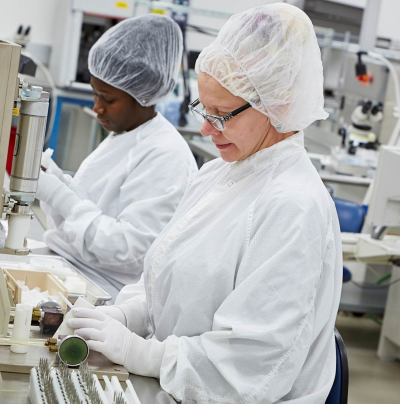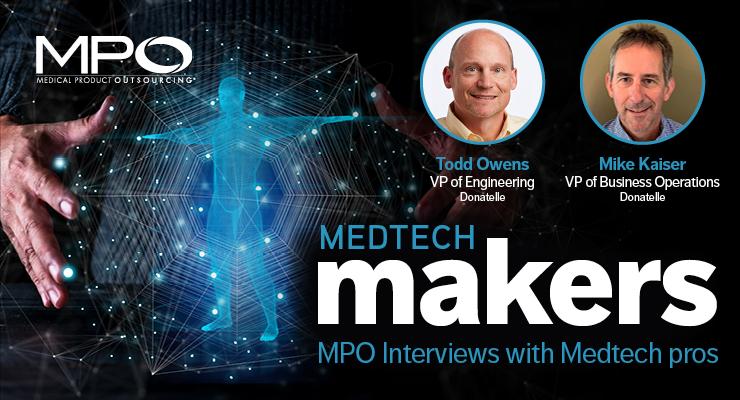When selecting a contract manufacturing partner, there is a bevy of criteria to consider. Experience, expertise, time in industry, certifications, number of locations, and many other factors all help determine who is the right fit for a medical device manufacturer. There are also considerations that cannot be as easily identified and may require further investigation.
One such item is time to market. This is an aspect of the development and manufacturing process that is critical to device makers, but not as easily uncovered. Some clues can be used, however, such as vertical integration which includes true full-service offerings from design through to packaging, sterilization, and shipping.
Seeking additional insight on optimizing time to market for medical device manufacturers, MPO spoke with representatives from Donatelle, a company that matches the aforementioned description of a vertically integrated, full-service contract manufacturer. Mike Kaiser, vice president of business operations, and Todd Owens, vice president of engineering, took time to offer their views on what it takes to expedite a product’s development and manufacturing lifecycle to gain in the race to market.
Sean Fenske: Expediting time to market is typically one of the top requirements for medical device OEMs. How do you respond about this topic when a new customer asks you about it?

Donatelle’s vertically integrated facility provides seamless results.
Because we’re a one-stop shop, we can help optimize our customer’s medical device concept for manufacturability through design, prototyping, validation, manufacturing, assembly, barcoding, packaging, labeling, sterilization management, and delivery. In addition, these capabilities, which are all under one roof, enable us to move the customer’s products through each stage of development seamlessly, with centralized communication and coordination.
We also adhere to the industry’s highest standards and best practices for quality and compliance, so customers know their products will meet stringent regulatory requirements. As a result, we can help them get to market faster.
Fenske: What systems do you have in place that are tied to expediting time to market for an OEM customer’s project?
Todd Owens: This starts with placing a strong emphasis on getting involved early in the design and development process (pre-design freeze) with customers. This can involve assuming responsibility for all or a portion of our customer’s product design, creating functional models or prototypes and/or providing design for manufacturability (DFM) intel as product design and requirements evolve. Our objective is to work collaboratively with customers. To do so, we leverage over 50 years of documented best practices and technical bench strength in our manufacturing processes to successfully avoid significant downstream time-impacting events.
Fenske: How do you optimize the transfer program of an OEM customer’s product to your facility to ensure time to market is kept top of mind?
Owens: We’ve been involved in multiple transfer programs. In order to optimize the process, it’s paramount to follow a controlled transfer program process that leverages documented lessons learned and best practices. This helps ensure all the elements critical to a successful and timely transfer are considered and addressed.
Thorough planning prior to execution of the transfer is another important consideration to an expedient and successful transfer. For reference, a few of the important elements that need to be considered and accounted for include condition of tooling, unresolved and/or chronic quality issues, historical run performance, and re-validation requirements, among other factors.
Another important contributor to fast-tracking a transfer is the “right-sizing” of a cross-functional team of resources to the complexity of the project and speed at which it needs to be completed within. This important element allows the optimization of concurrent activities to most effectively shorten time to completion. In most cases, when customers transfer manufacturing processes, tooling, fixtures, documentation, etc., from one supplier to another, the product is already in distribution and the supply chain is in motion, so any interruptions are absolutely unacceptable. Understaffing a transfer program can have a significant impact to this.
Fenske: How do you leverage design for manufacturability as a way to speed up time to market?
Owens: Design for manufacturability (DFM) is a risk mitigation tool that takes a proactive approach to problem avoidance during the product/process design phases versus a reactive approach following the occurrence of unforeseen issue(s) later during the development and validation phases.
A proven, successful roadmap to shorten overall development time and increase timeline reliability and compliance entails: 1) applying expertise and knowledge through cross-functional technical involvement, 2) leveraging well-documented best practices around all elements of the manufacturing processes, and 3) making this a transparent and collaborative team effort between supplier and customer.
Fenske: Where do you often find time-to-market savings that surprise customers? Does it require rethinking their plans?

Cross-functional resources shorten time to completion.
Another time-to-market savings is establishing a pre-production and production plan well ahead of the expected launch date and prior to development completion. This typically involves pulling in the customer’s production planning group ahead of when they typically get involved to understand the quantity needs, so we can execute the production ramp and continuity of the supply chain.
These are just a few examples of how we can help minimize risks and optimize delivery to help our customers’ save time to market.
Fenske: Does having vertically integrated capabilities give you an advantage in terms of expediting time to market versus a firm that specializes on only one or two aspects of the development lifecycle?
Kaiser: Yes, as a one-stop shop, we can manage all aspects of the supply chain, which breeds in continuity and seamlessness. This also enables us to focus resources on any long lead time areas and bottlenecks, if and as they arise, and achieve an expedited solution.
In addition, because we have vertically integrated capabilities under one roof and one Quality Management System, we can offer faster product movement through each manufacturing step and an overall reduced time to market.
Fenske: Do those capabilities include warehousing/logistics support so products move from being manufactured at your facility right to the OEM’s customers?
Kaiser: For programs that include a fully packaged and sterilized medical device, we typically ship to an OEM customer’s distribution center, and they, in turn, ship directly to their customers from that location. Donatelle has the systems in place—and proven experience—to further minimize production lead times through Kanban and vendor managed inventory programs.
Fenske: Do you have any additional comments you’d like to share based on any of the topics we discussed?
Kaiser: Yes, thank you. It’s important to note that Donatelle has an exemplary track record for regulatory compliance, meeting deadlines, and on-time delivery. We are an ISO 9001:2015 and 13485:2016 certified contract manufacturer and are FDA-registered. We follow Good Manufacturing Practices and are committed to providing absolute quality using state-of-the-art technologies, such as real-time statistical process controls that help ensure part and product consistency.
Owens: In the course of our history, we’ve produced millions of different devices and components for OEMs across medical markets, including cardiac, dental, diagnostics, drug delivery, neuromodulation, ophthalmic, orthopedics, surgical technologies, and vascular. Our highly qualified team is dedicated to helping customers solve manufacturing challenges and bring critical devices and components to market in spec, on time, and within budget.
Learn more about Donatelle >>>>>














